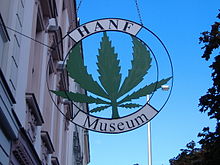Hemp Museum (Berlin)
- View a machine-translated version of the German article.
- Machine translation, like DeepL or Google Translate, is a useful starting point for translations, but translators must revise errors as necessary and confirm that the translation is accurate, rather than simply copy-pasting machine-translated text into the English Wikipedia.
- Do not translate text that appears unreliable or low-quality. If possible, verify the text with references provided in the foreign-language article.
- You must provide copyright attribution in the edit summary accompanying your translation by providing an interlanguage link to the source of your translation. A model attribution edit summary is
Content in this edit is translated from the existing German Wikipedia article at [[:de:Hanfmuseum]]; see its history for attribution. - You may also add the template
{{Translated|de|Hanfmuseum}}to the talk page. - For more guidance, see Wikipedia:Translation.
Hanf Museum | |
 | |
 | |
| Established | 6 December 1994 (1994-12-06) |
|---|---|
| Location | Berlin-Mitte, Mühlendamm 5 |
| Accreditation | DE-MUS-905915 |
| Owner | H.A.N.F. e. V. |
| Website | www |
The Hemp Museum (German: Hanf Museum Berlin) was opened in Berlin on 6 December 1994. It is the only museum in Germany focused on the cannabis plant.[1] The museum also actively promotes the protection of children and young people and offers individually tailored tours of the exhibition with care staff. It serves as a meeting place for the organisers of the Hanfparade. The Hanf Museum regularly takes part in the "Long Night of Museums", the Berlin Fairytale Days and the Historale which takes place in the Nikolai Quarter. In 2017, the Hanf Museum took part in the Kirchentag in Berlin as a self-organised event on the topic of the war on drugs with speakers from South American victims, including the Reverend Martin Diaz from El Salvador.[2]
About the exhibition
The exhibition covers around 250 m2 (2700 sq. ft.) and presents everything to do with cultivated plants. Starting with the general presentation, the growth and cultivation, the harvesting and processing of hemp is described from a historical perspective. Furthermore, the numerous possibilities of use are presented and consumer products are presented. The importance of hemp for different cultures of the world and also as a drug is illuminated. Special exhibitions, such as on cannabis as a medical law of 19 February 2017, supplement the current status.
The exhibition also documents the history of prohibition of THC-containing hemp.
Selected artists can present their works in the cellar. There is an opportunity to linger, watch films and talk to each other.
References
52°31′00″N 13°24′29″E / 52.5167°N 13.4081°E / 52.5167; 13.4081
- v
- t
- e
- Hanfparade
- Hemp Museum
- Lammbock (2001)
- Lommbock (2017)
- Angela Gossow
- Georg Wurth
 Category
Category
 | This article about a Berlin building or structure is a stub. You can help Wikipedia by expanding it. |
- v
- t
- e
 | This Cannabis-related article is a stub. You can help Wikipedia by expanding it. |
- v
- t
- e











